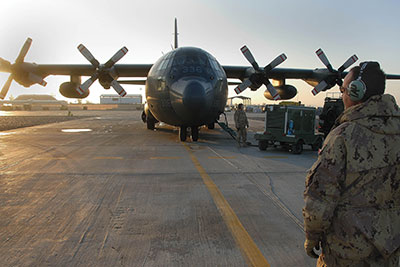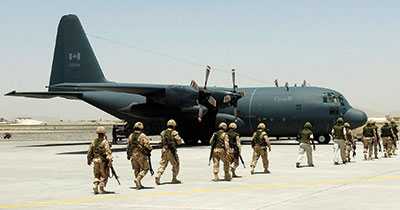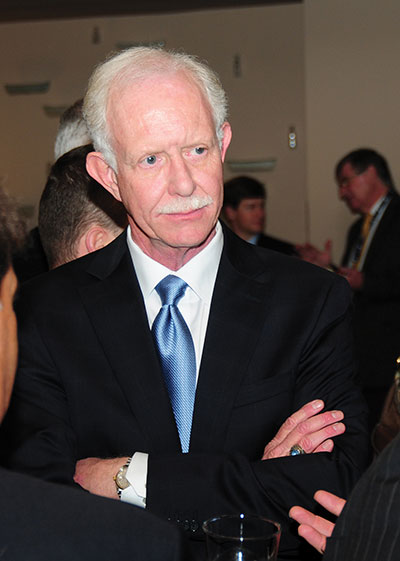
Features
Safety
Taking steps to avoid the inevitable
The theme of the 2013 CHC Safety and Quality Summit was “Building an Accident Free Legacy: Predictive Safety to Avoid ‘the Inevitable.’ ” It was all about inevitable outcomes – not accidents – as events that are entirely foreseeable and as such can be mitigated.
July 10, 2013 By Paul Dixon
The theme of the 2013 CHC Safety and Quality Summit was “Building an Accident Free Legacy: Predictive Safety to Avoid ‘the Inevitable.’ ” It was all about inevitable outcomes – not accidents – as events that are entirely foreseeable and as such can be mitigated.

|
| An engine check on a CC-130 Hercules before its early morning takeoff from Kandahar Airfield, Afghanistan. Dr. Michael Paul has worked with RCAF crews to study the effects of sleep deprivation. (Photo: Corporal Simon Duchesne, RCAF)
|
Aviation in Canada is barely past the century mark and commercial aviation has grown up with the baby boomers. Today, not only are we working around the clock, but we are also sending people halfway around the world in half a day and turning their personal world upside down in the process.

|
|
| Canadian soldiers head towards a waiting CC-130 Hercules aircraft on the tarmac at Kandahar Airfield.(Photo: Sgt. Dennis Power, RCAF) Advertisement
|
There is a single causal factor common to accidents large and small. The nuclear meltdown at Chernobyl, the Exxon Valdez oil spill, the space shuttle Challenger disaster and more than 100,000 traffic accidents a year in North America are a direct result of fatigue. Whether the determining factor was a skill-based error or an error in judgment, the underlying cause was fatigue. We describe these incidents as “accidents,” yet there is nothing accidental about any of these incidents as their outcomes were entirely predictable had consideration been given to the potential impacts of decreased cognitive functioning, impairments in alertness and performance caused by fatigue.
Over the past two decades, fatigue has increasingly been identified as a causal factor in aviation “accidents” or near misses resulting from poor reaction or poor decision-making. The root cause of individual fatigue is not a one-size-fits-all problem as there are many factors that influence the quantity and quality of sleep. Recent notable incidents where fatigue has been identified as a causal factor include:
- January 2012 runway overrun of a Boeing 737-700 operated by Enerjet in Fort Nelson, B.C. The approach speed was slightly faster than normal, resulting in the touchdown occurring beyond the recommended touchdown point on the runway, thus reducing the distance available to stop the aircraft. The autothrottle system was not disengaged after touchdown which led to the late application of the thrust reversers and speed brakes. The aircraft overran the runway by 230 feet. There were no injuries or damage to the aircraft. The crew did not follow the descent path indicated by the instrument landing system, which led to a faster approach. The faster approach and the autothrottle being left on for the touchdown contributed to the overrun. In addition, the investigation uncovered that the captain did not get sufficient sleep in the 24 hours before the flight.
- May 2009, an Air France A-330 carrying 228 people from Brazil to France crashed into the Atlantic Ocean, killing all on board. According to the judicial report, the pilot was suffering from extreme fatigue. “I didn’t sleep enough last night. One hour – it’s not enough,” pilot Marc Dubois was recorded as saying one hour into the flight. Dubois was taking a scheduled nap when the plane entered a tropical storm, and he reportedly took more than a minute to respond to his co-pilot’s calls for help.
- January 2011 a fatigued and groggy Air Canada co-pilot mistook Venus for an oncoming aircraft and took evasive action, sending the plane into a momentary dive that injured 16 passengers. The Transportation Safety Board found “sleep inertia” to blame for the co-pilot’s misjudgment.
- February 2009, a Colgan Air Dash-8 Q400 stalled on approach to Buffalo, N.Y, then crashed to the ground killing everyone on board and one person on the ground. The NTSB determined that the accident was caused by the pilots’ inability to respond properly to the stall warnings, through a lack of experience and that their performance was likely impaired because of fatigue.
Stanley Coren is a professor emeritus of psychology at the University of B.C. His research has covered many areas of neuropsychology and cognitive processing and his 1996 best-selling book Sleep Thieves delved into the mysteries of the perils of sleep deprivation. He describes how man has evolved over the past four million years, with lifestyle and behaviour patterns evolving at a rate incompatible with our physical evolution.
As hunter-gatherers, we evolved into a pattern of activity during daylight hours and rest during the dark. The first evidence of use of the simplest machines dates back a mere 5,000 years, when evidence of the wheel first appeared. The Industrial Revolution dates back to the 1760s, but it really didn’t hit its stride until the introduction of the electric light bulb and the alternating current electric motor in the late 1800s. Depending on the age of the reader, it is only four or five generations since the social model went from a world where most people’s daily patterns followed the sun according to a standard that had evolved over thousands of generations. We are now in a world that bombards us from multiple sources of stimulation and demands our attention at any hour of the night or day.
Covering a wider scope
Fatigue is not an isolated issue in the aviation industry, where pilots frequently have long and varied duty cycles and short rest periods, as well as frequent crossings of time zones. A recent National Sleep Foundation survey found that one in five pilots said that they’d made a “serious” error due to sleep deprivation. A 2006 survey of 162 short-haul commercial pilots in the U.K. found that three-quarters reported severe fatigue, and the vast majority said that the problem of fatigue was worse than two years before. Another report by the British Airline Pilots’ Association (BALPA) of 500 of its members showed 43 per cent had involuntarily fallen asleep in the cockpit, and of those, 31 per cent said that when they woke up the other pilot was also asleep.
Determining just how much performance is affected by sleep loss is difficult, in part because of factors such as individual differences in sensitivity to sleep deprivation, as well as individual differences in motivation to stay alert despite sleep loss. Even so, the evidence is clear that a lack of sleep leads to poor performance. As the prevalence of inadequate sleep grows and the demands of the workplace change, it becomes increasingly critical that we recognize and take action to mitigate the impact that insufficient sleep has on our safety and well-being.
The RCAF perspective
Michael Paul, a defence scientist with Defence Research and Development Canada in Toronto, was a featured presenter at this year’s CHC Safety and Quality Summit. His presentation was based on his years of work for the RCAF on human factors and aircrew fatigue. Paul has established compelling evidence that shows the effects sleep deprivation has in the day-to-day world by analyzing the impact of moving the clock backwards or forwards each year for daylight savings time.
“One of the most compelling Canadian statistics with respect to deleterious effects of sleep deprivation is based on more than one million motor vehicle accident records around the seasonal clock changes, such as moving our clocks forward in the spring (losing an hour of sleep) and moving our clocks back in the fall (gaining an hour of sleep),” he says. “On the Monday morning after the Saturday night spring clock change, motor vehicle accident rates are up by seven per cent and by later in the week, this seven per cent increase in accident rates has disappeared. In the fall, when we move our clocks backward and gain an additional hour of sleep, motor vehicle accident rates fall by seven per cent, but by later in the week, the accident rates are back up to normal. The only place in Canada where this does not happen is Saskatchewan where they don’t conduct seasonal adjustments of their clocks in the first place.”
If a two-dimensional task such as driving is that sensitive to a one-hour change in sleep, consider the impact on military and civilian pilots who are routinely subjected to multiple changes in time zones and workday patterns.
Dr. Paul first worked with RCAF crews operating into what is now Croatia in Op Alliance, which saw 18 CC-130 Hercules crews performing an airlift between CFB Trenton and Split (Croatia) via RAF Lyneham in the U.K. Crews were achieving their maximum flying time of 120 hours per 30-day period in as little as two weeks. The initial airlift consisted of six flights per day with 14 hours on the ground between mission legs and then shifted into a sustainment mode of three flights per week with 32 hours on the ground between flight legs. There was a fatigue-induced decrease in performance on the long outbound transatlantic leg and it was discovered that crews were having difficulty sleeping in the U.K. because though it was 22:00 local time, it was only 17:00 on their body clock time and they were out of phase with their bodies’ circadian rhythms.
In 2003, Paul was asked to evaluate CC-130 crews tasked on Op Tempo, supporting operations in Afghanistan after an unusually high number of flight safety incidents were reported. With daily missions into Kabul from Camp Mirage, crews were exceeding their maximum 30-day limit of 120 hours and were being given waivers to fly up to 150 hours in the 30-day period. Sleep data along with crew duty day data was used as inputs to a cognitive effectiveness modelling program.
The findings were troubling. Crews that had just arrived in theatre and commenced operations were operating at a level of reduced efficiency of 77.5 per cent, equal to a Blood Alcohol Concentration (BAC) of 0.05 per cent and often would deteriorate to a level of 70 per cent cognitive efficiency, equal to a BAC of 0.08 per cent. At times, some individuals would slip even lower in the efficiency scale, to a point that Dr. Paul describes as “clinical stupidity.” Crews that had been in theatre for a month and had time to adjust their body clocks had no problems, but it was the effect of nine hours of time zone shift and the resulting change in sleeping patterns that played havoc with newly arrived crews. Performance would improve by each day, but it was clearly shown that full recovery takes nine to 10 days.
The RCAF response to these findings was a mandatory five-day acclimation period (after arrival in theatre) prior to commencement of flying operations. The RCAF also funded a four-year project to optimize our ability to manipulate circadian rhythms (forwards or backwards) to counter jetlag and shift-lag.
Ironing the point home
Dr. Scott Shappell has been a mainstay of the CHC Safety and Quality Summit since its inception. Currently chair of the department of human factors and systems at Embry-Riddle Aeronautical University, he has also served human factors research branch manager at the Civil Aerospace Medical Institute and served for more than 16 years in the U.S. navy as an aerospace experimental Psychologist. Shappell developed a program of time-shifting naval pilots during the period aircraft carriers were deploying from stateside to station while he served with the navy and supporting carrier aviation groups. By pre-planning and controlling the environment of the pilots onboard the carrier, pilots’ body cycles were acclimated to the region they would be operating in by the time their ship arrived on station. This enabled the naval air group to be fully operational from the first possible moment.
In his presentation at CHC, Shappell shared a more personal story on the effects of sleep deprivation and one that most people can more readily identify with: a lesson learned from his father.
His father taught him how to play poker in Las Vegas and make money at it, by understanding some very basic factors about human behaviour and sleep deprivation – that and just a bit of self-discipline. The plan went like this. You join a poker table in the evening and play for a couple of hours. No matter what is happening, you leave the game at 11 p.m. and go to bed. Then you set the alarm for 5 a.m. and come back down to the poker table. Many of the same players will still be sitting there, suffering from the lack of sleep and a few free drinks, just waiting for the well-rested player to sit down and take their money.
It works and as Shappell emphasizes, whether it’s playing poker, driving a car or flying an airplane, the worst judge of your current condition and ability to perform the task(s) at hand is you.

|
|
| Chesley “Sully” Sullenberger at 2012 CHC Safety and Quality Summit in Vancouver: “We learn from the mistakes of others because no one can live long enough to see all the mistakes.” (Photo: Paul Dixon)
|
Sully’s perspective
Captain Chesley “Sully” Sullenberger was the keynote speaker at the 2012 CHC Safety and Quality Summit. Now retired from US Airways, he has become the public face of a campaign in the U.S. to have the FAA change the regulations on pilot duty hours and fatigue management. Interviewed by ABC News several months after the Flight 1549 incident, Sullenberger was asked if he could have done what he did if he had not been fully rested before starting his duty day. He replied, “I’m convinced that had we been tired, had we not got sufficient rest the night before, we could not have performed at the same level. The fact that we got so much so right so quickly under that sudden stress is a testament not only to our training, but also that we had a chance to get sufficient rest.”
Asked if there was a system in place to ensure that pilots were properly rested, Sullenberger diplomatically responded, “not completely,” and went on to reference the rule changes that the FAA was then contemplating to update flight-time and duty-time rules for the first time in more than a generation. “I don’t know what the companies’ motivation is, but their actions indicate it is not a big concern to them, but it is a big concern to me,” he said.
During his research for the book Sleep Thieves, Coren interviewed an unnamed pilot who described his job in this way: “Flying a plane is just shiftwork in the sky and some of the shifts are pretty brutal.” As technology improves and aircraft fly higher, faster and farther, the toll on the humans tasked with flying them will only become more exacting. How close are we to the point where the ability of the machine outstrips the ability of the human to keep pace?